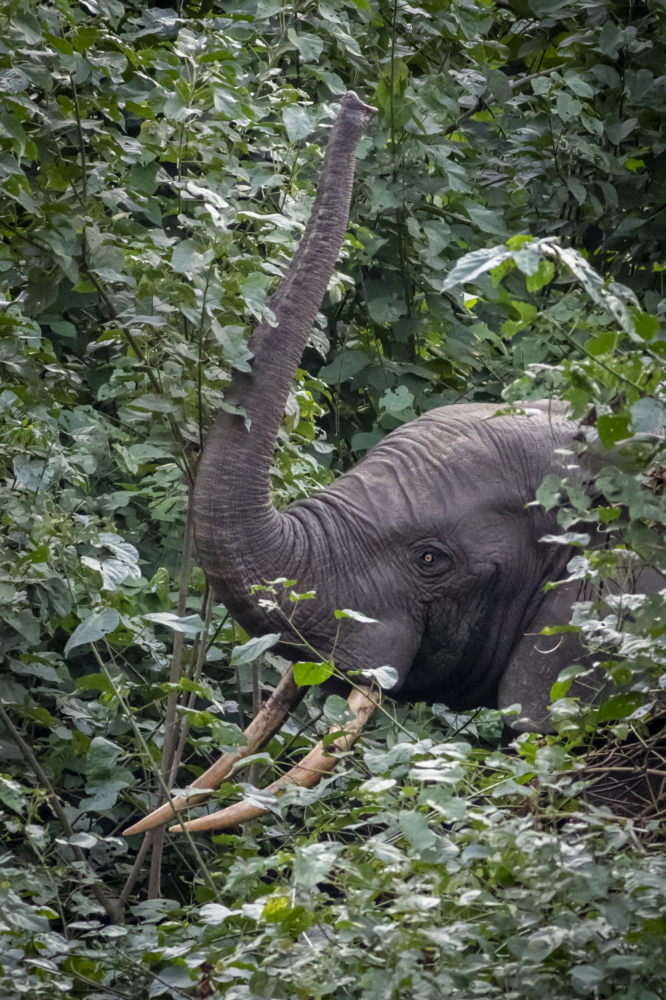Article published in PNAS
How elephants contribute to carbon storage in rainforests

The impacts of megaherbivores, i.e. species reaching a weight of more than 1000 kg, on the structure and functioning of forest ecosystems are still very poorly understood. In a study published online in PNAS (to be published on January 31, 2023), and in which François Bretagnolle and Clémentine Durand-Bessart of UMR Biogéosciences are co-authors, Fabio Berzaghi et al. combined and analyzed a dataset from seven sites in forested Africa on the nutritional values of nearly 150 species of plants on which forest elephants (Loxodonta cyclotis) feed. The results suggest that these animals favor trees with high wood density by consuming the more digestible leaves and branches of trees with low wood density. In addition, the fruits and seeds of trees dispersed by elephants come from species with a higher wood density than trees dispersed by other vectors, animals or abiotics. The decline of forest elephants could thus lead to structural changes towards tropical forests richer in trees with low wood density. Such a change could result in a 6-9% drop in above-ground carbon stored in African rainforests. According to the authors, this study highlights the functional role of this species in the functioning of forest ecosystems as well as the role it plays in the carbon storage of these forest massifs. More generally, the conservation of megaherbivores in the forest can contribute to mitigating global warming by storing atmospheric carbon in the wood.
Reference
Berzaghi F, Bretagnolle F, Durand-Bessart C & Blake S (2023) Megaherbivores modify forest structure and increase carbon stocks through multiple pathways. PNAS 120 (5) e2201832120. https://doi.org/10.1073/pnas.2201832120
- extrait:
- lien_externe:
- kc_data:
- a:8:{i:0;s:0:"";s:4:"mode";s:0:"";s:3:"css";s:0:"";s:9:"max_width";s:0:"";s:7:"classes";s:0:"";s:9:"thumbnail";s:0:"";s:9:"collapsed";s:0:"";s:9:"optimized";s:0:"";}
- kc_raw_content:
How elephants contribute to carbon storage in rainforests

The impacts of megaherbivores, i.e. species reaching a weight of more than 1000 kg, on the structure and functioning of forest ecosystems are still very poorly understood. In a study published online in PNAS (to be published on January 31, 2023), and in which François Bretagnolle and Clémentine Durand-Bessart of UMR Biogéosciences are co-authors, Fabio Berzaghi et al. combined and analyzed a dataset from seven sites in forested Africa on the nutritional values of nearly 150 species of plants on which forest elephants (Loxodonta cyclotis) feed. The results suggest that these animals favor trees with high wood density by consuming the more digestible leaves and branches of trees with low wood density. In addition, the fruits and seeds of trees dispersed by elephants come from species with a higher wood density than trees dispersed by other vectors, animals or abiotics. The decline of forest elephants could thus lead to structural changes towards tropical forests richer in trees with low wood density. Such a change could result in a 6-9% drop in above-ground carbon stored in African rainforests. According to the authors, this study highlights the functional role of this species in the functioning of forest ecosystems as well as the role it plays in the carbon storage of these forest massifs. More generally, the conservation of megaherbivores in the forest can contribute to mitigating global warming by storing atmospheric carbon in the wood.Reference
Berzaghi F, Bretagnolle F, Durand-Bessart C & Blake S (2023) Megaherbivores modify forest structure and increase carbon stocks through multiple pathways. PNAS 120 (5) e2201832120. https://doi.org/10.1073/pnas.2201832120
